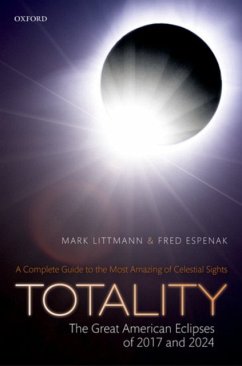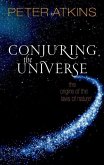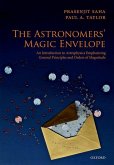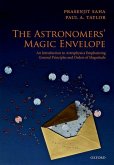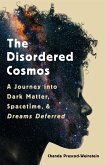Mark Littmann (Professor, University of Tennessee, Knoxville), Fred Espenak (NASA - Goddard Space Flight Astrophysicist emeritus
Totality: The Great American Eclipses of 2017 and 2024
Mark Littmann (Professor, University of Tennessee, Knoxville), Fred Espenak (NASA - Goddard Space Flight Astrophysicist emeritus
Totality: The Great American Eclipses of 2017 and 2024
- Gebundenes Buch
- Merkliste
- Auf die Merkliste
- Bewerten Bewerten
- Teilen
- Produkt teilen
- Produkterinnerung
- Produkterinnerung
A complete guide to solar eclipses for the general public with detailed coverage of the 2017 and 2024 total eclipses over the U.S. Well timed for the August 2017 eclipse over North America, it shows how, when, and where to see the coming total solar eclipses, how to photograph and video record them, and how to do so safely.
Andere Kunden interessierten sich auch für
![Conjuring the Universe Conjuring the Universe]() Peter Atkins (Fellow of Lincoln College Oxford)Conjuring the Universe18,99 €
Peter Atkins (Fellow of Lincoln College Oxford)Conjuring the Universe18,99 €![The Astronomers' Magic Envelope The Astronomers' Magic Envelope]() Prasenjit Saha (University of Zurich Titular Professor of Physics)The Astronomers' Magic Envelope75,99 €
Prasenjit Saha (University of Zurich Titular Professor of Physics)The Astronomers' Magic Envelope75,99 €![Signatures of the Artist Signatures of the Artist]() Steven E. Vigdor (Emeritus Professor Emeritus Professor of PhysicsSignatures of the Artist46,99 €
Steven E. Vigdor (Emeritus Professor Emeritus Professor of PhysicsSignatures of the Artist46,99 €![The Astronomers' Magic Envelope The Astronomers' Magic Envelope]() Prasenjit Saha (Titular Professor of Titular Professor of PhysicsThe Astronomers' Magic Envelope38,99 €
Prasenjit Saha (Titular Professor of Titular Professor of PhysicsThe Astronomers' Magic Envelope38,99 €![Conjuring the Universe Conjuring the Universe]() Peter Atkins (Fellow of Lincoln College Oxford)Conjuring the Universe12,99 €
Peter Atkins (Fellow of Lincoln College Oxford)Conjuring the Universe12,99 €![Eclipse Eclipse]() Frank Close (Professor, Professor, University of Oxford)Eclipse21,99 €
Frank Close (Professor, Professor, University of Oxford)Eclipse21,99 €![The Disordered Cosmos The Disordered Cosmos]() Chanda Prescod-WeinsteinThe Disordered Cosmos24,99 €
Chanda Prescod-WeinsteinThe Disordered Cosmos24,99 €-
-
-
A complete guide to solar eclipses for the general public with detailed coverage of the 2017 and 2024 total eclipses over the U.S. Well timed for the August 2017 eclipse over North America, it shows how, when, and where to see the coming total solar eclipses, how to photograph and video record them, and how to do so safely.
Produktdetails
- Produktdetails
- Verlag: Oxford University Press
- Seitenzahl: 288
- Erscheinungstermin: 1. Mai 2017
- Englisch
- Abmessung: 242mm x 167mm x 32mm
- Gewicht: 828g
- ISBN-13: 9780198795698
- ISBN-10: 0198795696
- Artikelnr.: 47208661
- Verlag: Oxford University Press
- Seitenzahl: 288
- Erscheinungstermin: 1. Mai 2017
- Englisch
- Abmessung: 242mm x 167mm x 32mm
- Gewicht: 828g
- ISBN-13: 9780198795698
- ISBN-10: 0198795696
- Artikelnr.: 47208661
Mark Littmann has written several popular books about astronomy. Planets Beyond: Discovering the Outer Solar System won the Science Writing Award of the American Institute of Physics. Planet Halley: Once in a Lifetime (Donald K Yeomans, co-author) won the Elliott Montroll Special Award of the New York Academy of Sciences. Reviewers described The Heavens on Fire: The Great Leonid Meteor Storms as a unique achievement, altogether satisfying, and a compelling read. Mark holds an endowed professorship, the Hill Chair of Excellence in Science Writing, at the University of Tennessee where he teaches three different courses in writing about science, technology, medicine, and the environment. He has helped lead expeditions to Canada, Hawaii, Bolivia, Aruba, and Turkey to observe total eclipses. ; Fred Espenak is the most widely recognized name in solar eclipses. He is an astrophysicist emeritus at NASA's Goddard Space Flight Center, where he founded and runs the NASA Eclipse Home Page <>, the most consulted website for eclipse information around the globe. His Five Millennium Canons of solar and lunar eclipses are seminal works for researchers, archaeologists, and historians. Fred writes regularly on eclipses for Sky & Telescope and is probably the best known of all eclipse photographers. He leads expeditions for every total solar eclipse and has done so for more than 35 years. In 2003, the International Astronomical Union honored Espenak and his eclipse work by naming asteroid 14120 after him.
1 The Experience of Totality
2 The Great Celestial Cover-Up
3 Ancient Efforts to Understand
4 Eclipses in Mythology
5 The Strange Behavior of Man and Beast - Long Ago
6 The Sun at Work
7 The First Eclipse Chasers
8 The Eclipse that Made Einstein Famous
9 Observing a Total Eclipse
10 Eye Safety During Solar Eclipses
11 The Strange Behavior of Man and Beast - Modern Times
12 Eclipse Photography
13 The All-American Eclipse of 2017
14 The Weather Outlook
15 When Is the Next One? Total Eclipses: 2018-2023
16 Coming Back to America: The Eclipse of 2024
17 Epilogue
AppA Maps for Every Solar Eclipse 2017-2045
App B Total, Annular, and Hybrid Eclipses: 2017-2060
App C Recent Total, Annular, and Hybrid Eclipses: 1970-2016
App D Total Eclipses in the United States: 1492 to 2100
2 The Great Celestial Cover-Up
3 Ancient Efforts to Understand
4 Eclipses in Mythology
5 The Strange Behavior of Man and Beast - Long Ago
6 The Sun at Work
7 The First Eclipse Chasers
8 The Eclipse that Made Einstein Famous
9 Observing a Total Eclipse
10 Eye Safety During Solar Eclipses
11 The Strange Behavior of Man and Beast - Modern Times
12 Eclipse Photography
13 The All-American Eclipse of 2017
14 The Weather Outlook
15 When Is the Next One? Total Eclipses: 2018-2023
16 Coming Back to America: The Eclipse of 2024
17 Epilogue
AppA Maps for Every Solar Eclipse 2017-2045
App B Total, Annular, and Hybrid Eclipses: 2017-2060
App C Recent Total, Annular, and Hybrid Eclipses: 1970-2016
App D Total Eclipses in the United States: 1492 to 2100
1 The Experience of Totality
2 The Great Celestial Cover-Up
3 Ancient Efforts to Understand
4 Eclipses in Mythology
5 The Strange Behavior of Man and Beast - Long Ago
6 The Sun at Work
7 The First Eclipse Chasers
8 The Eclipse that Made Einstein Famous
9 Observing a Total Eclipse
10 Eye Safety During Solar Eclipses
11 The Strange Behavior of Man and Beast - Modern Times
12 Eclipse Photography
13 The All-American Eclipse of 2017
14 The Weather Outlook
15 When Is the Next One? Total Eclipses: 2018-2023
16 Coming Back to America: The Eclipse of 2024
17 Epilogue
AppA Maps for Every Solar Eclipse 2017-2045
App B Total, Annular, and Hybrid Eclipses: 2017-2060
App C Recent Total, Annular, and Hybrid Eclipses: 1970-2016
App D Total Eclipses in the United States: 1492 to 2100
2 The Great Celestial Cover-Up
3 Ancient Efforts to Understand
4 Eclipses in Mythology
5 The Strange Behavior of Man and Beast - Long Ago
6 The Sun at Work
7 The First Eclipse Chasers
8 The Eclipse that Made Einstein Famous
9 Observing a Total Eclipse
10 Eye Safety During Solar Eclipses
11 The Strange Behavior of Man and Beast - Modern Times
12 Eclipse Photography
13 The All-American Eclipse of 2017
14 The Weather Outlook
15 When Is the Next One? Total Eclipses: 2018-2023
16 Coming Back to America: The Eclipse of 2024
17 Epilogue
AppA Maps for Every Solar Eclipse 2017-2045
App B Total, Annular, and Hybrid Eclipses: 2017-2060
App C Recent Total, Annular, and Hybrid Eclipses: 1970-2016
App D Total Eclipses in the United States: 1492 to 2100

